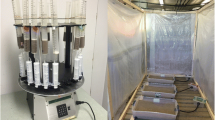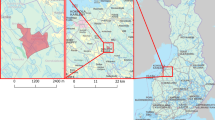Abstract
On the coastal plains of Finland there are approximately 3,000 km2 of acid sulfate soils developed as a result of intensive agricultural drainage of waterlogged sulfide-bearing sediments. The runoff from these soils contains very high amounts of acidity and metals that have severely deteriorated the aquaculture in several downstream rivers and estuaries. Therefore, there is an urgent need to develop and test more environmental friendly ways of draining landscapes underlain with these nasty soils. In this study, over a 3-year monitoring period the effect of excess surface liming, controlled drainage and lime filter drainage of acid sulfate soils on runoff water quality (pH, sulfate, metals) was determined and assessed. The results showed that (1) the liming measures had not prevented severely acidic and metal-rich waters from forming and discharging from the soils, (2) the controlled drainage system might have reduced discharge peaks but its potential effects on the discharged water quality were nondetectable due to its small effect on the groundwater level and naturally inherited heterogeneities, and (3) the spatial and temporal variations identified for the various hydrochemical determinants were not caused by the kind of treatment applied. Therefore, on acid sulfate soil fields, like the one studied here, the short-term hydrochemical effects of the treatments tested are minor (or nonexistent) at least as long as the controlled drainage systems are not technically improved or better maintained.
Similar content being viewed by others
References
Åström, M. (1998). Partitioning of transition metals in reduced and oxidised zones of sulfide-bearing fine-grained sediments. Applied Geochemistry, 13, 617–697.
Åström, M. (2001). Effect of widespread severely acidic soils on spatial features and abundance of trace elements in streams. Journal of Geochemical Exploration, 73, 181–191.
Åström, M., & Åström, J. (1997). Geochemistry of stream water in a catchment in Finland affected by sulphidic fine sediments. Applied Geochemistry, 12, 593–605.
Åström, M., & Björklund, A. (1995). Impact of acid sulphate soils on stream water geochemistry in western Finland. Journal of Geochemical Exploration, 55, 163–170.
Åström, M., & Spiro, B. (2000). Impact of isostatic uplift and ditching of sulphidic sediments on the hydrochemistry of major and trace elements and sulphur isotope ratios in streams, western Finland. Environmental Science and Technology, 34, 1182–1188.
Bärlund, I., Tattari, S., Yli-Halla, M., & Åström, M. (2002). Effect of intensified surface liming, control drainage and lime filter drainage on groundwater level and drainage water quality on acid sulphate soils at research fields in Ilmajoki and Mustasaari, Report by the Finnish Environment Institute, 44 pp. http://www.vyh.fi/eng/research/projects/hapsu/hapsufinal.doc.
Cook, F. J., Hicks, W., Gardner, E. A., Carlin, G. D., & Froggatt, D. W. (2000). Export of acidity in drainage water from acid sulphate soils. Marine Pollution Bulletin, 41, 319–326.
Dent, D. L., & Pons, L. J. (1995). A world perspective on acid sulphate soils. Geoderma, 67, 263–276.
Eden, P., Weppling, K., & Jokela, S. (1999). Natural and land-use induced load of acidity, metals, humus and suspended matter in Lestijoki, a river in western Finland. Boreal Environment Research, 4, 31–43.
Evans, R. D., & Skagg, R. W. (1989). Design guidelines for water table management systems on coastal plain soils. Applied Engineering in Agriculture, 5, 539–548.
FAO (1988). FAO/UNESCO ‘Soil map of the world,’ revised legend, world resources report 60. Rome: FAO.
Gill, R. (1997). Modern analytical geochemistry. Harlow: Longman, 329 pp.
Gilliam, J. W., Osmond, D. L., & Evans, R. D. (1997). Selected agricultural best management practices to control nitrogen in the Neuse River basin. North Carolina Agricultural Research Service Technical Bulletin, 311, 53 pp. Retrieved from http://www.soil.ncsu.edu/publications/BMPs/.
Hooli, J., Laakso, E., & Palko, J. (1993). Water protection in acid sulfate soils. Water Science and Technology, 28, 199–203.
Hudd, R., & Leskelä, A. (1998). Acidification-induced species shifts in coastal fisheries of the river Kyrönjoki, Finland: A case study. Ambio, 27, 535–538.
Joukainen, S., & Yli-Halla, M. (2003). Environmental impacts and acid loads from deep sulfidic layers of two well-drained acid sulfate soils in western Finland. Agriculture, Ecosystems & Environment, 95, 297–309.
Kawalec, A. (1973). World distribution of acid sulphate soils. In H. Dost (Ed.), Acid Sulphate Soils, Proc. Int. Symp. on Acid Sulphate Soils, International Institute for Land Reclamation and Improvement Publication, 18, pp. 293–295.
Öborn, I. (1991). Some effects of chemical weathering in three cultivated acid sulfate soils in Sweden. In R. J. Wright, V. C. Baligar, & R. P. Murrmann (Eds.), Plant-soil interactions at low pH, Development in Plant and Soil Sciences, 45, 55–63.
Österholm, P. (2005). Previous, current and future leaching of sulphur and metals from acid sulphate soils in W. Finland. PhD thesis. Åbo Akademi University, 35 pp.
Österholm, P., & Åström, M. (2002). Spatial trends and losses of major and trace elements in agricultural acid sulphate soils distributed in the artificially drained Rintala area, W. Finland. Applied Geochemistry, 17, 1209–1218.
Österholm, P., & Åström, M. (2004). Quantification of current and future leaching of sulfur and metals from Boreal acid sulfate soils, western Finland. Australian Journal of Soil Research, 42, 547–551.
Palko, J. (1994). Acid sulphate soils and their agricultural and environmental problems in Finland. PhD thesis. University of Oulu, Acta Universitatis, Ouluensis, C 75, 58 pp.
Palko, J., & Yli-Halla, M. (1993). Assessment and management of acidity release upon drainage of acid sulphate soils in Finland. In D. L. Dent & M. E. F. van Mensvoort (Eds.), Selected papers of the Ho Chi Minh City symposium on acid sulphate soils (pp. 411–418). International Institute for Land Reclamation and Improvement.
Ritsema, C. J., van Mensvoort, M. E. F, Dent, D. L., Tan, Y., van den Bosch, H., & van Wijk, A. L. M. (2000). Acid sulfate soils. In M. E. Sumner (Ed.), Handbook of Soil Science (pp. 121–154). Boca Raton: CRC Press (Section G).
Sammut, J., White, I., & Melville, M. D. (1996). Acidification of an estuarine tributary in Eastern Australia due to drainage of acid sulfate soils. Marine & Freshwater Research, 47, 669–684.
Soil Survey Staff (1996). Keys to Soil Taxonomy, 7th ed. USDA, Natural Resources Conservation Service, U.S. Government Printing Office, 644 pp.
Sundström, R., Åström, M., & Österholm, P. (2002). Comparison of the metal content in acid sulphate soil runoff and industrial effluents in Finland. Environmental Science and Technology, 36, 4269–4272.
Urho, L., Hilden, M., & Hudd, R. (1990). Fish reproduction and the impact of acidification in the Kyrönjoki River estuary in the Baltic Sea. Environmental Biology of Fishes, 27, 273–283.
Weppling, K. (1993). Hydrochemical factors affecting the neutralization demand in acid sulphate waters. Vatten, 49, 161–170.
Wesström, I., Ekbohm, G., Linnér, H., & Messing, I. (2003). The effects of controlled drainage on subsurface outflow from level agricultural fields. Hydrological Processes, 17, 1525–1538.
Wesström, I., Messing, I., Linnér, H., & Lindström, J. (2001). Controlled drainage – Effects on drain outflow and water quality. Agricultural Water Management, 47, 85–100.
White, I., Melville, M. D., Wilson, B. P., Price, C. B., & Willett, I. R. (1993). Understanding acid sulphate soils in canelands. In R. T. Bush (Ed.), Proceedings of the national conference on acid sulphate soils, Coolangatta (CSIRO, NSW Agriculture, Tweed Shire Council), pp. 130–148.
Author information
Authors and Affiliations
Corresponding author
Rights and permissions
About this article
Cite this article
Åström, M., Österholm, P., Bärlund, I. et al. Hydrochemical Effects of Surface Liming, Controlled Drainage and Lime-Filter Drainage on Boreal Acid Sulfate Soils. Water Air Soil Pollut 179, 107–116 (2007). https://doi.org/10.1007/s11270-006-9217-8
Received:
Accepted:
Published:
Issue Date:
DOI: https://doi.org/10.1007/s11270-006-9217-8




